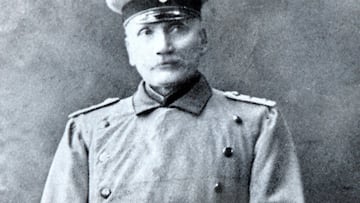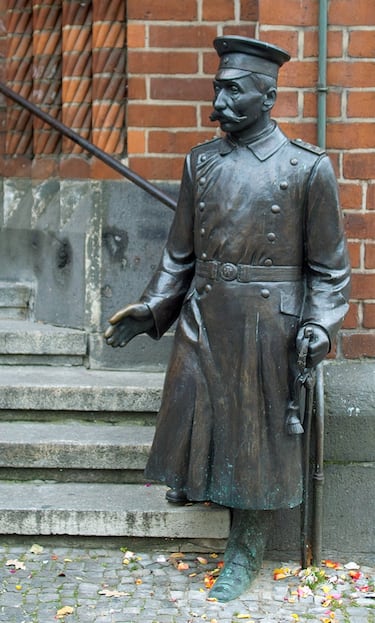On this date in 1906: The wild true story of a shoemaker, a squad of soldiers and a stolen fortune
In 1906, a desperate shoemaker pulled off one of the most audacious heists in history by impersonating a Prussian army captain.

When it comes to pulling off bold and ingenious robberies, the “Captain of Köpenick” heist of 1906 has to be up there with most brazen of all.
Wilhelm Voigt had learned his trade as a cobbler from his father but ended up as a petty thief spending more time in prison than mending shoes.
Am heutigen 16. Oktober jährt sich der legendäre Kassenraub des Jahres 1906 mit Verhaftung des #Köpenick|er Bürgermeisters durch den Schuster Wilhelm Voigt alias #HauptmannvonKöpenick zum 117. Mal. Wer mehr erfahren will, besucht unsere Dauerausstellung 👉 https://t.co/6hhqJDxmTQ pic.twitter.com/OKlEj16bhL
— Bezirksamt Treptow-Köpenick (@BaBerlinTK) October 16, 2023
In an out of jail for most of his life
After being released in February 1906, Voigt spent the next few months drifting - unemployed, with no income and living with his sister Bertha and her husband, Manza. As the months dragged on, and his situation remained unchanged, he grew more and more desperate.
One day, Voigt had a brainwave. He would raise funds by staging a robbery. Such a plan would have to be executed in broad daylight, he would need to wear some kind of disguise. Then it occurred to him that by impersonating a captain of the First Regiment of the Prussian Guard Infantry, he would neither be challenged, nor recognized.
Voigt took a train to a nearby garrison town Potsdam, where he found exactly what he was looking for - a military uniform in a secondhand shop run by a Jewish merchant. It fitted him perfectly.
Instantly transformed, he looked every bit the part of a high-ranking military official and more importantly, an authoritative figure - someone in a position of power who people who automatically obey.
Voigt’s ruse was coming together. What followed would become one of the most legendary hoaxes of recent times - a story that is equally tragic as it is theatrical.
2. The Rathaus Köpenick, an extensive, turreted redbrick Wilhelmine building in the Old Town, was the site of a famous heist in 1906 by wastrel out-of-work cobbler Wilhelm Voigt. The Schuster dressed as a Prussian officer and ordered a contingent of troops inside to the town… pic.twitter.com/nUEl4A4BgZ
— Slow Travel Berlin (@slowberlin) September 5, 2025
Voigt puts his plan into action
On the afternoon of October 16, 1906, Voigt, dressed in his captain’s uniform boarded a train for Tegel, a suburb in West Berlin. On arrival, he headed straight to a military barracks where he commandeered a squad of ten soldiers.
Voigt then led his new “troops” onto a commuter train bound for Köpenick, an independent town east of Berlin. The men, unaware of the ruse, followed orders without question.
Once in Köpenick, Voigt marched his squad to the town hall, blocked all exits, and declared that no one was allowed to move through the corridors. He then arrested the mayor, Georg Langerhans, and the town clerk, Rosenkranz, for political corruption “in the name of His Majesty Wilhelm II”. He summoned the local police, instructing them to maintain order.
Voigt then located the town treasurer, Von Wiltburg, and ordered him to “render accounts.” Together, they withdrew 3,557.45 Reichsmarks from the nearby Imperial Post Office. The treasurer dutifully recorded the transaction, sealed the money bags, and handed them over. Voigt signed the receipt using the name of his former prison warden, Von Malzahn, adding the initials H.i.1.G.R.—“Captain of the 1st Regiment of the Guard.”
To transport the mayor and treasurer to Berlin’s military station, Voigt hired a horse-drawn carriage and took their word of honor that they wouldn’t flee. Before leaving, he ordered the soldiers to guard the town hall for another 30 minutes and blocked Köpenick post office for an hour to prevent anyone from alerting Berlin. Voigt promptly vanished, boarding the next train to Berlin with his swag bag.

The “Captain of Köpenick” heist dominates the headlines
The incident made the headlines not just in Germany but all across Europe. The press speculated about who the mysterious “Captain of Köpenick” could be and how he pulled off such an audacious coup. Voigt was eventually shopped by a former cellmate. He was arrested 10 days after his heist, as he eating breakfast.
He was sentenced to four years in Tegel Prison for disturbing public order, kidnapping, fraud, and impersonating a government official. But the German public found the story hilarious - and at the same time painfully tragic . In August 1908, Kaiser Wilhelm II granted him a full pardon. Voigt died in Luxembourg in 1922, aged 72.
The daring stunt became a symbol of blind obedience to authority and the absurdity of bureaucracy—immortalized in plays, films, and even wax museums. More than a century later, the tale of the shoemaker who stole a town hall remains one of Germany’s most legendary capers.
Related stories
Get your game on! Whether you’re into NFL touchdowns, NBA buzzer-beaters, world-class soccer goals, or MLB home runs, our app has it all.
Dive into live coverage, expert insights, breaking news, exclusive videos, and more – plus, stay updated on the latest in current affairs and entertainment. Download now for all-access coverage, right at your fingertips – anytime, anywhere.
Complete your personal details to comment